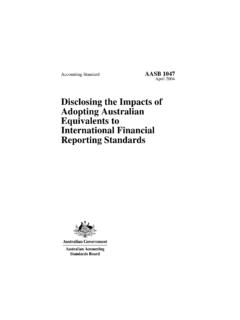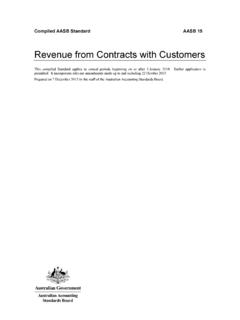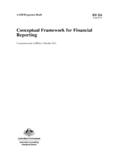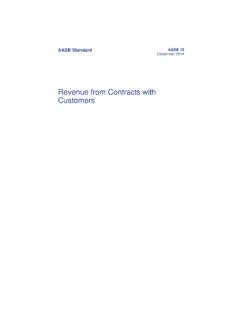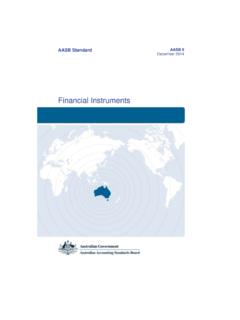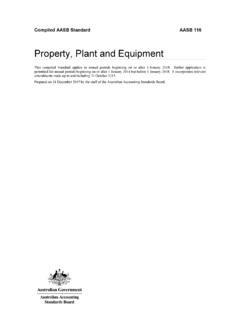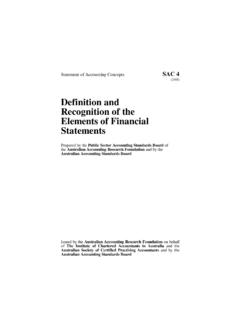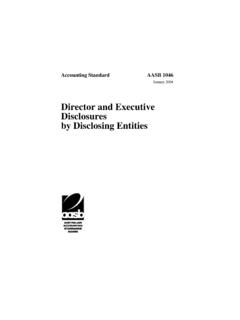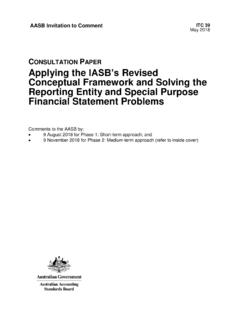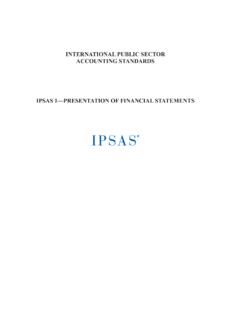Transcription of Presentation of Financial Statements
1 Compiled Accounting Standard AASB 101 Presentation of Financial Statements This compiled Standard applies to annual reporting periods beginning on or after 1 January 2006. Early application is permitted. It incorporates relevant amendments made up to and including 8 September 2005. Prepared on 16 August 2007 by the staff of the Australian Accounting Standards Board. AASB 101-compiled 2 COPYRIGHT Obtaining Copies of Accounting Standards The most recently compiled versions of Standards, original Standards and amending Standards (see Compilation Details) are available on the AASB website: Printed copies of original Standards and amending Standards are available for purchase by contacting: The Customer Service Officer Australian Accounting Standards Board Level 7 600 Bourke Street Melbourne Victoria AUSTRALIA Postal address: PO Box 204 Collins St West Victoria 8007 AUSTRALIA Phone: (03) 9617 7637 Fax: (03) 9617 7608 E-mail: Website: Other Enquiries Phone: (03) 9617 7600 Fax: (03) 9617 7608 E-mail.
2 COPYRIGHT 2007 Commonwealth of Australia This compiled AASB Standard contains International Accounting Standards Committee Foundation copyright material. Reproduction within Australia in unaltered form (retaining this notice) is permitted for personal and non-commercial use subject to the inclusion of an acknowledgment of the source. Requests and enquiries concerning reproduction and rights for commercial purposes within Australia should be addressed to The Director of Finance and Administration, Australian Accounting Standards Board, PO Box 204, Collins Street West, Victoria 8007. All existing rights in this material are reserved outside Australia. Reproduction outside Australia in unaltered form (retaining this notice) is permitted for personal and non-commercial use only.
3 Further information and requests for authorisation to reproduce for commercial purposes outside Australia should be addressed to the International Accounting Standards Committee Foundation at AASB 101-compiled 3 CONTENTS CONTENTS COMPILATION DETAILS COMPARISON WITH INTERNATIONAL PRONOUNCEMENTS ACCOUNTING STANDARD AASB 101 Presentation OF Financial Statements Paragraphs Objective 1 Application Scope 3 6 Purpose of Financial Reports 7 Components of a Financial Report 8 10 Definitions 11 12 Overall Considerations Fair Presentation and Compliance with Australian Accounting Standards 13 22 Going Concern 23 24 Accrual Basis of Accounting 25 26 Consistency of Presentation 27 28 Materiality and Aggregation 29 31 Offsetting 32 35 Comparative Information 36 41 Structure and Content Introduction 42 43 Identification of the Financial Report 44 Reporting Period 49 50 Balance Sheet Current/Non-current Distinction 51 Current Assets 57 59 Current Liabilities 60 67 Information to be Presented on the Face of the
4 Balance Sheet 68 73 Information to be Presented either on the Face of the Balance Sheet or in the Notes 74 77 AASB 101-compiled 4 CONTENTS Income Statement Profit or Loss for the Period 78 80 Information to be Presented on the Face of the Income Statement 81 85 Information to be Presented either on the Face of the Income Statement or in the Notes 86 95 Statement of Changes in Equity 96 100 Cash Flow Statement 102 Notes Structure 103 107 Disclosure of Accounting Policies 108 115 Key Sources of Estimation Uncertainty 116 124 Other Disclosures 125 Appendix: Illustrative Financial Report Structure Page 47 AUSTRALIAN IMPLEMENTATION GUIDANCE Page 56 BASIS FOR CONCLUSIONS ON IAS 1 (available on the AASB website) Australian Accounting Standard AASB 101 Presentation of Financial Statements (as amended) is set out in paragraphs 1 and the Appendix.
5 All the paragraphs have equal authority. Terms defined in this Standard are in italics the first time they appear in the Standard. AASB 101 is to be read in the context of other Australian Accounting Standards, including AASB 1048 Interpretation and Application of Standards, which identifies the UIG Interpretations. In the absence of explicit guidance, AASB 108 Accounting Policies, Changes in Accounting Estimates and Errors provides a basis for selecting and applying accounting policies. AASB 101-compiled 5 COMPILATION DETAILS COMPILATION DETAILS Accounting Standard AASB 101 Presentation of Financial Statements as amended This compiled Standard applies to annual reporting periods beginning on or after 1 January 2006. It takes into account amendments up to and including 8 September 2005 and was prepared on 16 August 2007 by the staff of the Australian Accounting Standards Board (AASB).
6 This compilation is not a separate Accounting Standard made by the AASB. Instead, it is a representation of AASB 101 (July 2004) as amended by other Accounting Standards, which are listed in the Table below. Table of Standards Standard Date made Application date (annual reporting periods .. on or after ..) Application, saving or transitional provisions AASB 101 15 Jul 2004 (beginning) 1 Jan 2005 AASB 2004-3 22 Dec 2004 (beginning) 1 Jan 2006 see (a) below AASB 2005-10 5 Sep 2005 (beginning) 1 Jan 2007 not compiled* AASB 2005-11 8 Sep 2005 (ending) 31 Dec 2005 see (b) below AASB 2007-6 14 Jun 2007 (beginning) 1 Jan 2009 not compiled* * The amendments made by this Standard are not included in this compilation, which presents the Standard as applicable to annual reporting periods beginning on or after 1 January 2006.
7 (a) Entities may elect to apply this Standard to annual reporting periods beginning on or after 1 January 2005 but before 1 January 2006, provided that AASB 119 Employee Benefits (December 2004) is also applied to such periods. (b) Entities may elect to apply this Standard to annual reporting periods beginning on or after 1 January 2005 that end before 31 December 2005. AASB 101-compiled 6 COMPILATION DETAILS Table of Amendments to Standard Paragraph affected How affected By .. [paragraph] 91 amended AASB 2005-11 [7] 96 amended AASB 2004-3 [8] 113 amended AASB 2005-11 [8] Appendix, Part C amended AASB 2004-3 [8]
8 Table of Amendments to Australian Implementation Guidance Paragraph affected How affected By .. [paragraph] Part C, Example 1 amended AASB 2004-3 [9] AASB 101-compiled 7 COMPARISON COMPARISON WITH INTERNATIONAL PRONOUNCEMENTS AASB 101 and IAS 1 AASB 101 as amended is equivalent to IAS 1 Presentation of Financial Statements as issued and amended by the IASB. Paragraphs that have been added to this Standard (and do not appear in the text of the equivalent IASB standard) are identified with the prefix Aus , followed by the number of the relevant IASB paragraph and decimal numbering. Compliance with IAS 1 Entities that comply with AASB 101 as amended will simultaneously be in compliance with IAS 1 as amended. AASB 101 and IPSAS 1 International Public Sector Accounting Standards (IPSASs) are issued by the International Public Sector Accounting Standards Board of the International Federation of Accountants.
9 IPSAS 1 Presentation of Financial Statements (May 2000) is drawn primarily from IAS 1 Presentation of Financial Statements (revised 1997). The main differences between IPSAS 1 and AASB 101 are: (a) AASB 101 allows the Presentation of either a statement showing all changes in net assets/equity, or a statement showing changes in net assets/equity other than those arising from capital transactions with owners and distributions to owners in their capacity as owners. IPSAS 1 requires the Presentation of a statement showing all changes in net assets/equity; and (b) IPSAS 1 allows the Presentation of extraordinary items . In contrast, AASB 101 does not permit extraordinary items to be presented. AASB 101-compiled 8 STANDARD ACCOUNTING STANDARD AASB 101 The Australian Accounting Standards Board made Accounting Standard AASB 101 Presentation of Financial Statements under section 334 of the Corporations Act 2001 on 15 July 2004.
10 This compiled version of AASB 101 applies to annual reporting periods beginning on or after 1 January 2006. It incorporates relevant amendments contained in other AASB Standards made by the AASB up to and including 8 September 2005 (see Compilation Details). ACCOUNTING STANDARD AASB 101 Presentation OF Financial Statements Objective 1. The objective of this Standard is to prescribe the basis for Presentation of general purpose Financial reports, to ensure comparability both with the entity s Financial reports of previous periods and with the Financial reports of other entities. To achieve this objective, this Standard sets out overall requirements for the Presentation of Financial reports, guidelines for their structure and minimum requirements for their content.
